- NEW DVD Series – Stone Setting with Bezels
- Tube Set Charm by Kim St. Jean
- Prong Basket Pendant by Kim St. Jean
- NEW DVD Series – Stone Setting with Cold Connections
- New DVD Series – Stone Setting with Wire
- NEW DVD Series: Introduction to Stone Setting by Kim St. Jean
- Featured Tool: Bracelet Bending Plier
- NEW Dvd by Eva Sherman
- Fun, Fast Fold Forming DVD Series
- Double Band Ear Cuff from Alex Simkin
Gem Profile: Garnet
by Layna Palmer, Wire-Sculpture.com

Garnet
Garnet, that beautiful deep red stone, January’s birthstone and the color of Persephone’s pomegranate seeds and the promise of spring in a cold month. Though most garnets are red, they do come in a rainbow of colors due to varying chemical compositions within the basic crystal formation. We will take a look at red and reddish garnet varieties today, and then take a peek at the greens and other colors next week.
Garnet got its name from the word granatus, meaning “grain” in Latin. This may be a reference to pomum granatum, “pomegranate,” whose juicy fruit resembles the color and shape of garnet gems.
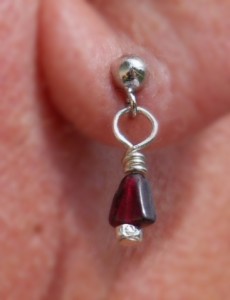
Andrea Kump-Eicher made a pair of garnet drop earrings with wire for a dear friend who has a January birthday.
Garnets are classified as a silicate mineral and develop in a dodecahedron most often (a shape with 12 sides, or 12 faces). Garnets can also develop as a trapezohedron with 24 faces. In geometrical terminology the shape is called deltoidal icositetrahedron… good luck with pronouncing that! To translate, garnet crystals form in a cubic shape with three axes of equal length, and the color of the stone is decided by which mineral lies on either the X or Y axis. Due to the type of crystal formation, garnets don’t have cleavage planes and can fracture into irregular shapes. But you don’t need worry about your own garnet gems fracturing with normal use.

Dawn Neumann created this garnet necklace and earrings set using garnet beads and her chainmaille designs.
Garnet Properties
Garnets have a wonderful clarity and durable hardness between 6.5 and 7.5. Some garnets do have inclusions that create a star effect with the almandine group and “horsetail” inclusions in andradite garnets.
Because of the clarity and hardness of the stone, garnets can be cut into any shape. The only thing they don’t really like is intense heat and rough handling. We have talked in the past about some of the enhancements or treatments other stones go through to change their hardness and color. Garnets are not typically treated or enhanced, but some can change color under different lighting.
Garnets are found worldwide with various colors being found in specific places. Almost every variety of garnet can be found in the United States. Other beautiful locations that have garnet deposits are in South America, China, Russia, Turkey, and many parts of Africa.
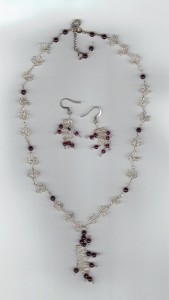
Ruth Soucek used garnet beads and wire filigree components to create a garnet necklace and earrings set.
How Red is a Garnet?
Most of us are familiar with the saturated deep red color of garnets. But some have specific names. Rholdolite garnets are a beautiful purplish red or rose color with Almandite giving us red with a violet undertone. We also have Hessonite, which is brownish-red, as opposed to Pyrope which is red with a hint of brown. Rounding out the reds, we have Spessartite, first found in Namibia and called “Mandarin Spessartine” due to its orange-red color.
Garnet made the news several times in 1996. A 19th century garnet brooch belonging to the estate of the late Jacqueline Kennedy Onassis was sold at Sotheby’s for $145,000.00. That same year, the world’s largest garnet was found in Australia. This whopper weighs thousands of tons and is nearly 100 feet across. Not bad for a university student!
Garnets in Antiquity
Garnets have been used in jewelry from ancient Egypt, Greece, and Rome. Recently a hoard was unearthed in Staffordshire England that sported an 8th century Anglo-Saxon sword hilt of garnet cloisonne.
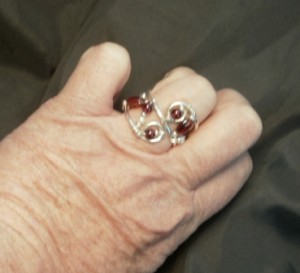
Freeform Garnet ring by Marcia Scarborough. Marcia used 14-gauge round soft silver wire for the frame, and 21-gauge round half hard wire to attach garnet and silver beads and Swarovski cream pearls.
Garnet Symbolism and Legends
Red garnets are a symbol for the passion of life. The color is motivational and a reminder of fire and blood helping to bring forth deep feelings and passion, increase devotion and the ability to see the serious side of life.

Carolyn Jones created this garnet heart from sterling silver wire and 4mm garnet beads, complementing it with a handmade clasp with a garnet accent.
Metaphysically speaking, scarlet garnets are said to be amulets of protection, reflecting strength and vitality, helping with physical pleasures in love and life. Orange garnets are happy and help integrate our lives with family, friendship and bring us closer in our companionships and home. The red garnet is said to be a powerful healing for base chakra blockages located at the base of the spine. When the base chakra is in balance, we can tune into our personal power and regain strength both physically and mentally.
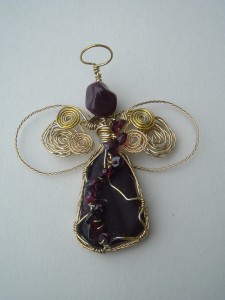
Sheila Mosher collects gemstones as well as sea glass and recycled glass. This wire wrapped angel is made from red recycled glass, with a sash of garnet chip beads.
Ancients used the word “carbuncle” to describe garnets as well as other red stones. A carbuncle was said to have been in the lantern that illuminated Noah’s Ark, according to legend. Since the legend arose, explorers and travelers alike have carried garnet as a talisman, because of the protective nature of the stone. Garnet has been assigned astrologically to the planets Mars, Mercury, and Pluto and is thought to reflect the colors of the cosmos.
Have you had the fortune to wire wrap tsavorite or any non-red varieties of garnet? Send us a picture at tips@wire-sculpture.com and we’ll feature it in next week’s gem profile, which will take a look at the non-red garnet stones. I’ll also share some beautiful red garnet photos sent in by readers that I couldn’t squeeze into today’s profile. See you then!
Resources & Recommended Reading
Gem Profile by Layna Palmer
Click to Receive Daily Tips by Email





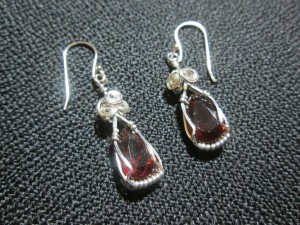
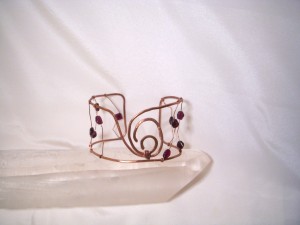
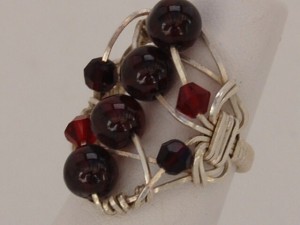















Pingback: Tsavorite and Green Garnets: Not just Red! | Jewelry Making Blog | Information | Education | Videos